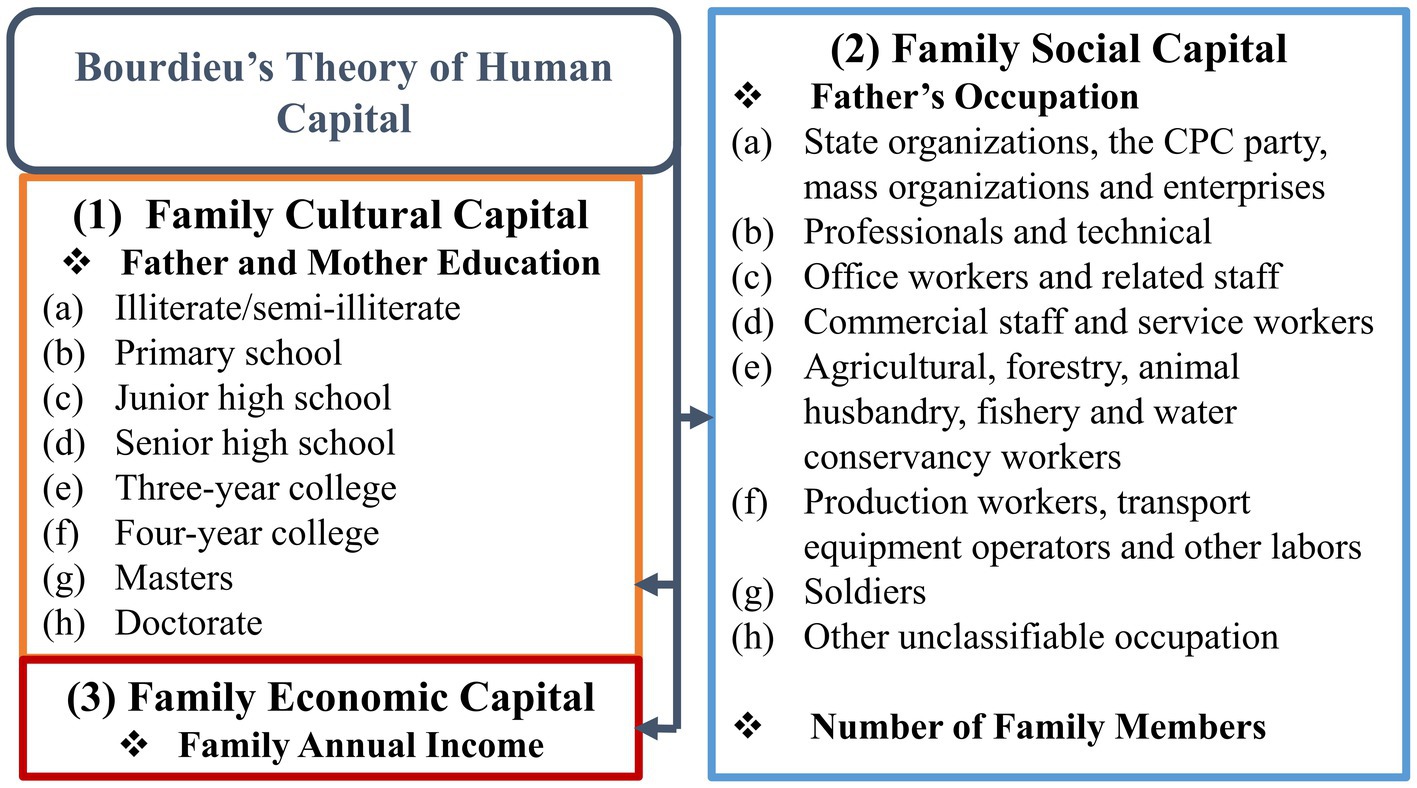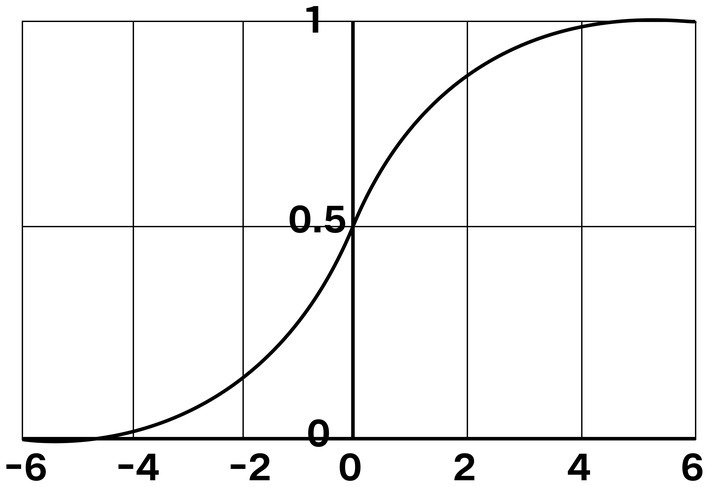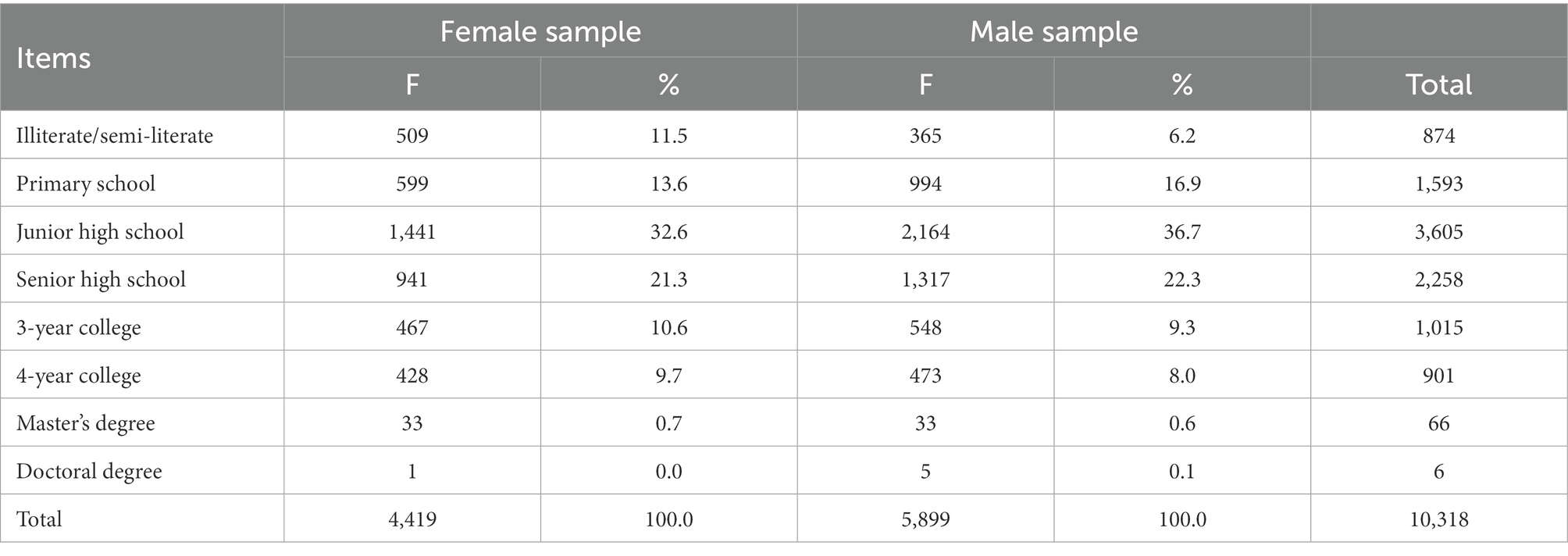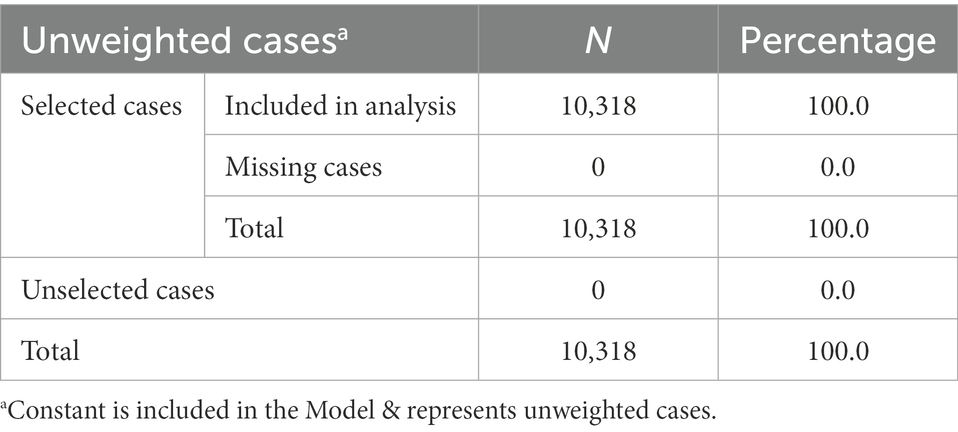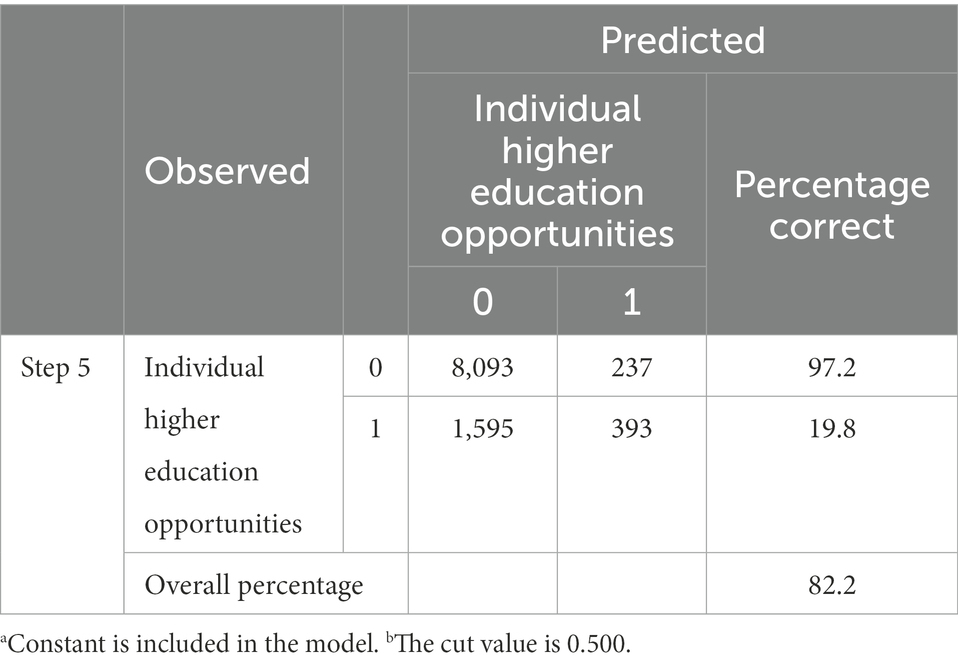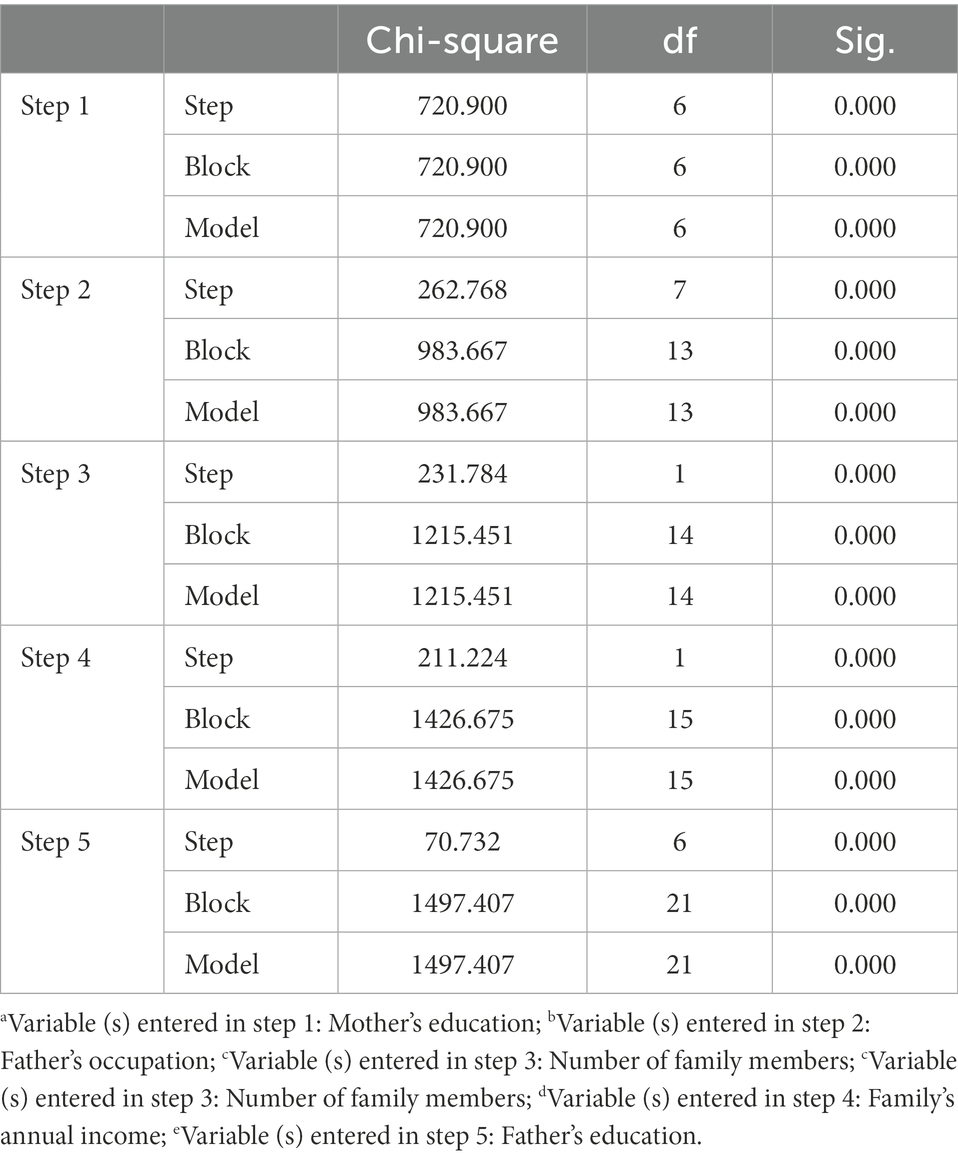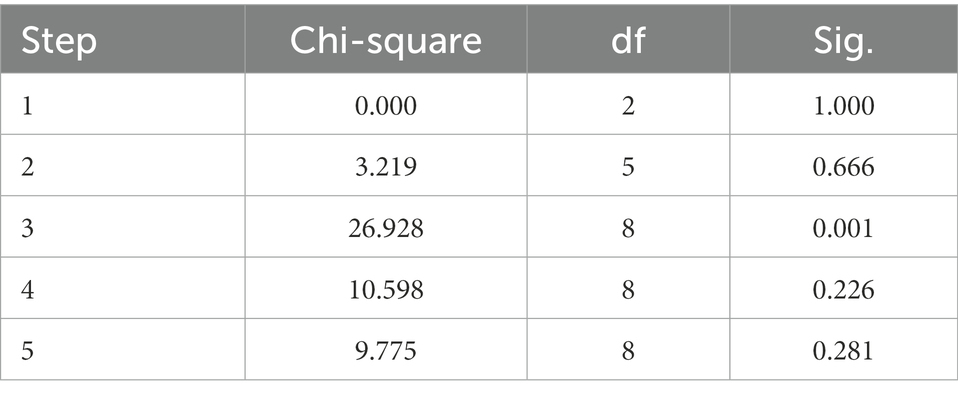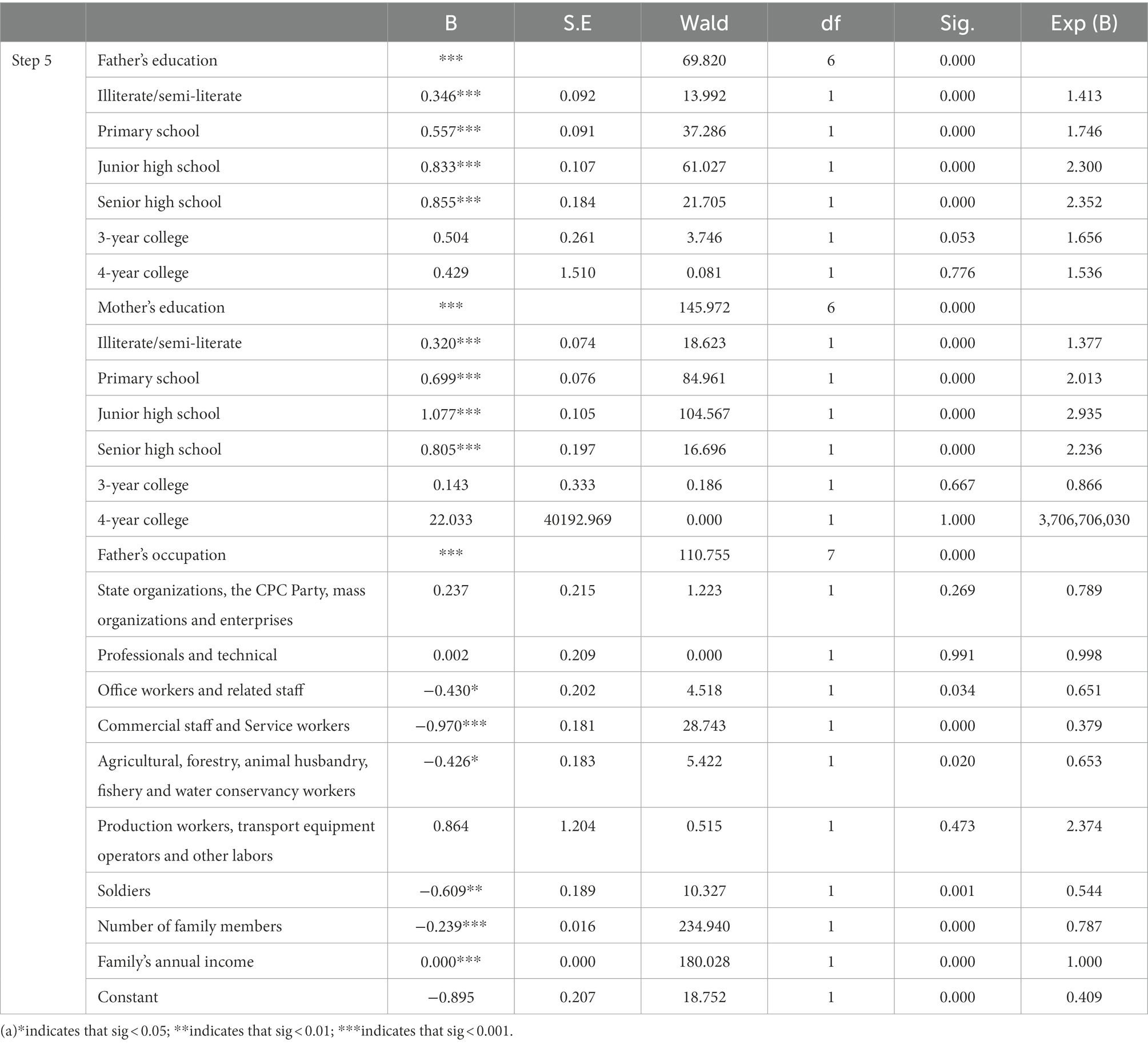- 1Center for Studies of Education and Psychology of Ethnic Minorities in Southwest China, Southwest University, Chongqing, China
- 2China School of Foreign Languages and Literature, Southwest University, Chongqing, China
- 3College of International Education, Sichuan International Studies University, Chongqing, China
This paper employs Bourdieu’s theory of capital—focusing on family cultural, social, and economic capital—to research the early-stage mechanism through which access to higher education is formed. While all three types of capital play a significant role in acquiring higher education, most studies tend to focus on just one type of capital. In recent years, domestic scholars have also analyzed in detail the family factors affecting children’s access to higher education (CAHE); however, they have not yet explained the mechanism by which these factors influence CAHE, and authentic tests are rare. Therefore, based on existing research, this paper uses the theoretical concept of family capital to reveal how contemporary Chinese families affect their CAHE. This paper analyzes the relationship between family capital, social stratification, and access to higher education opportunities using an econometric model based on baseline data from the China Family Panel Studies (CFPS) from 2010 to 2020, with 10,318 participants, including 4,419 females and 5,899 males. The results of a binary logistic regression analysis show that the possession of family cultural and economic capital has a direct positive influence on CAHE. Children from the elite stratum often benefit more from the accumulation of family cultural capital. Moreover, although it does not form a distinct stratum, the possession of family social capital also significantly influences children’s access to higher education. Driven by China’s political, economic, and social environment, some children from the blue-collar stratum have a comparative advantage in terms of access to higher education. The possession of family capital is an important factor in the stratification of CAHE, and cultural capital is the most influential type of capital. Parents with a low level of education should be encouraged to become engaged in schools and communities to take professional courses in assisted learning, emotional counseling, decision-making, and voluntary service.
1. Introduction
Educational equity is related to national development and people’s livelihoods (Duerrenberger and Warning, 2018). Against a backdrop of educational reform, theoretical research relating to educational equity provides a valuable assessment of change. Higher education is becoming increasingly integrated into our lives as an important tool to help improve the status of children from social strata that possess few social resources (Li and Qiu, 2018). Academic qualifications and access to social resources are strongly correlated (Zhao and Qin, 2021). People with higher academic qualifications can achieve higher prestige occupations and obtain more income and rights (de Wit and Altbach, 2021).
Among the many factors affecting access to higher education opportunities is a family’s amount of capital, which has a direct differential influence on the acquisition of children’s education (Aitken et al., 2019). An objective elimination mechanism does exist in higher education institutions, but the elimination criteria are the social strata of individual families (Althusser, 2019). Since the capital and habitus possessed by families from the dominant stratum potentially create symbolic violence, and the hidden exclusion from resources continues to aggravate the “involution” of education, equity becomes impossible to achieve (Gao et al., 2021).
According to Bourdieu and Passeron (1990), families with a high socioeconomic status (SES) provide extra educational resources for their children, leading to higher academic achievement in adolescents. Moreover, according to Coleman (1988), families with a high SES are often able to provide their children with a better living environment. As a result, their children have access to additional educational resources, and they do not need much parental involvement. Adolescents from low SES families benefit more from parental involvement than those from high SES families.
Based on the model of cultural mobility, Dimaggio (1982) argued that low SES levels encourage parents to invest in their children in order to compensate for other disadvantages. According to Liu et al. (2014), based on data from the Independent Freshman Admissions office at an elite university, adolescents from affluent families are more likely to succeed in the university admissions process. For adolescents in low SES families with less social capital, their parents’ involvement is more significant.
Due to the importance of access to higher education to future social stratification, relevant scholars in pedagogy and sociology have focused on “what factors lead to the differences in access to higher education for children of different families” (Mishra, 2020). Among the many factors affecting higher education access, family social status is considered the most essential structural element (Roksa and Kinsley, 2019; Liu and Morgan, 2020). The higher a family’s social status, the more likely its children are to receive higher education (Van Bavel et al., 2018). This conclusion conforms to Bourdieu’s theory of capital and has been confirmed by many other scholars (Romele, 2021).
The impact of family capital on children’s access to higher education (CAHE) is not applied directly. Instead, it is a long-term effect of certain specific factors. Although domestic scholars have analyzed in detail the family factors affecting CAHE in recent years, they have not yet explained the mechanism by which these factors influence CAHE, and authentic tests are rare. Therefore, based on existing research, this paper uses the theoretical perspective of family capital to reveal how contemporary Chinese families affect their CAHE.
In light of the fact that education has become increasingly important for class mobility, and that Chinese families face educational anxiety and social involution. This paper employs Bourdieu’s theory of capital—focusing on family cultural, social, and economic capital—to research the early-stage mechanism through which access to higher education is formed. While all three types of capital play a significant role in acquiring higher education, most studies tend to focus on just one type of capital. However, they have not yet explained the mechanism by which these factors influence CAHE, and authentic tests are rare. Therefore, based on existing research, this paper uses the theoretical concept of family capital to reveal how contemporary Chinese families affect their CAHE. As part of this study, we aim to gain a better understanding of the types of family capital that affect CAHE. This paper uses baseline data from the China Family Panel Studies (CFPS) from 2010 to 2020 to answer the following questions:
1. Does a significant difference exist in CAHE among children from families with different levels of family capital?
2. Is CAHE primarily influenced by the distribution of family capital?
2. Theoretical background and hypothesis
Due to its strong explanatory power, the concept of “capital” has been widely used across multiple research fields. French sociologist Bourdieu (2005) argued in “The Forms of Capital” that human capital takes diverse forms and can usually be divided into cultural, social, and economic capital. Accumulating any type of capital requires time and energy (Breinholt and Jæger, 2020). As a kind of accumulated labor, when exclusively possessed by actors or their aggregates, capital can provide social resources in a specific form. Cultural capital refers to a personal temperament that can be inherited and accumulated, such as interest preferences, knowledge literacy, and technical ability. These are usually represented by educational background and the possession of a diploma (Pokrovskaia et al., 2019). Social capital refers to the aggregate of actual or potential resources that individuals can obtain through an institutionalized social network, and it is the product of continuous effort, long-term operations, and the reciprocal communication of interest. This form of capital is usually characterized by professional status and number of family members (Ehsan et al., 2019; Shiell et al., 2020). Economic capital refers to explicit material wealth from which currency can be obtained by direct exchange. This capital includes operating, wage, and property income; government subsidies; and economic support from others, for example (Bauer and Zanjani, 2021).
Bourdieu’s distinction between these three types of capital has prompted scholars to examine how families with different cultural, social, and economic backgrounds take advantage of their existing capital to help their children attain a better education or higher social status, or to maintain their current status (Gilleard, 2020). Data analyzed from 14 universities in Jiangsu Province, China, showed that advantages related to family cultural capital are indirectly converted into educational opportunities, improving the likelihood that children will receive a higher education (Yao et al., 2015; Zhimin and Yao, 2015). In addition, Children from families with a high level of cultural capital have a better chance of studying at China’s top universities (Hu and Wu, 2021).
Du (2018) researched the influence of father’s occupational background on CAHE. The results showed that children with fathers in mid- and senior-level white-collar jobs are more likely to receive a higher education than children whose fathers have a lower occupational status. Wu et al. (2020) also noted that children from middle and upper class families enroll in higher education at a higher rate than those from lower class families.
Guo and Min (2006) established a relevant measurement model based on urban household survey data from the National Bureau of Statistics of China. Children whose families possess sufficient economic capital have a greater chance of receiving a higher education than children from poorer families. Kaye (2021) also confirmed that gaps in family income inevitably result in an inequality of access to higher education. However, Duan et al. (2018) noted that parental involvement, rather than economic conditions, is the primary source of family capital that contributes to CAHE.
Although all three types of capital are found to play a significant role in the acquisition of a higher education, most studies focus on a single type of capital. However, according to Bourdieu’s theory of multiple forms of capital, the study of the influence of family capital on CAHE cannot limit itself to one type. Instead, this question requires a comprehensive analysis of the action mechanism of cultural, social, and economic family capital (Li et al., 2020).
This paper incorporates the three types of capital into one analytical framework. It compares the intensity and direction of their influence on CAHE for different families. Moreover, it considers the relationship between families’ strata and their children’s access to higher education. Following Bourdieu’s theory of human capital (Figure 1), this paper develops the following measurement indicators: (1) Father’s and mother’s highest academic qualification is selected as the measurement index of “family cultural capital,” and (2) father’s occupation and number of family members are selected as the measurement index of “family social capital.” Following the National Standard Occupational Classification of the People’s Republic of China, family size is determined by the number of family members with the same registered residence as the subject. Finally, (3) “family economic capital” is measured using the family’s total income over the past 12 months.
The literature review suggests that family capital has a significant effect on the access of children from different strata to higher education. Therefore, this paper puts forward the following three hypotheses:
H1: The amount of family cultural capital has a direct positive influence on CAHE.
H2: The amount of family social capital has a direct positive influence on CAHE.
H3: The amount of family economic capital has a direct positive influence on CAHE.
3. Methodology
3.1. Sample data and research process
Descriptive statistical methods were used in this study. All the data sets in this research come from the latest entries in the CFPS open database. By tracking and collecting microdata from three levels (individual, family, and community), the CFPS project surveys the economic and non-economic welfare of Chinese residents (CFPS, 2015). It tracks data in several research areas, such as educational achievements, economic activities, population migration, family relations and dynamics, and health through a multidisciplinary, large-scale social tracking survey at the national level. The CFPS project includes a broad sample and a rich volume of data. Its interviews began in 2010, with data from that year acting as the baseline. Since then, the data have been updated via interviews every 2 years. So far, the project has completed five tracking interviews, in 2012, 2014, 2016, 2018, and 2020, covering 25 provinces, municipalities, and autonomous regions. The target sample size is 16,000 families, and the survey’s object category is all the family members of a sample family.
The research process contains data collection and data analysis. In the process data collection, it focuses on respondents aged 18+ (as of 2020). The main variables include the following aspects: (1) basic information about the respondents, such as gender, academic qualifications, and registered residence; and (2) the respondents’ family background, namely parents’ education level, father’s occupation, number of family members, and annual family income. After discarding surveys with missing values, odd ratio, and other related variables, a total of 10,318 respondents were included in the research data set for use in the research hypothesis test. Zhimin and Yao (2015) used logistic regression analysis of survey data from 14 representative universities in Jiangsu Province is conducted to analyze the impact of family capital on the quantity and quality of higher education achieved by individuals. In line with previous studies, binary logistic regression model was used to analyze screened data to determine whether family capitals have a direct impact on CAHE.
3.2. Design variables
The dependent variable was set as “whether children can obtain higher education enrollment opportunities.” The independent variables were set as “father’s highest academic qualification (dummy variable),” “mother’s highest academic qualification (dummy variable),” “father’s occupation (dummy variable),” “number of family members (continuous variable),” and “family annual income (continuous variable).” The control variable was set as “gender of the sample (i.e., men and women as separate categories, with women as the base variable)” and “registered residence of the respondent (i.e., urban and rural as separate categories, with rural as the benchmark variable).”
The dependent variables were coded as follows: children have access to higher education = 0; children have no access to higher education = 1.
Parents’ highest academic qualification were coded as follows: illiterate/semi-literate = 1; primary school = 2; junior high school = 3; senior high school = 4; 3-year college = 5; 4-year college = 6.
Father’s occupation was coded as follows: the CPC Party, state organizations, mass organizations and enterprises = 1; professionals and technical = 2; employees of the office and related personnel = 3; workers in the commercial and service sectors = 4; forestry, agricultural, and animal husbandry workers and workers in the fields of fisheries and water conservation = 5; production workers, operators of transportation equipment and other laborers = 6; soldiers = 7.
3.3. Analysis model
To test the hypotheses, the logit model was adopted to investigate the influence of family capital on CAHE. Firstly, the logistic distribution function was used, expressed as F(x) = ex/(1 + ex), where the range of x is (−∞, +∞); the value range of F(x) is (0, 1) with a monotonically rising S-shaped curve (Figure 2).
Let the probability P of an event depend on multiple independent variables (X1, X2, …, XK); then P = eβ0 + β1X1 + β2X2 + … + βkXk + μ/(1 + eβ0 + β1X1 + β2X2 + … + βkXk + μ), where the range of P is (0, 1), and the range of β0 + β1X1 + β2X2 + … + βkXk + μ is (−∞, +∞). Then the relationship between the probability of the event and the variables fits the binary logistic regression model or the logarithmic dominance linear regression model.
That is, Ln[p/(1 – p)] = β0 + β1X1 + β2X2 + … + βkXk + μ, where β0 is a constant term, β1, β2, …, βk are the regression coefficients of k independent variables, and μ is the error term.
The following regression model was built according to the sample data in this paper:
L = Ln(opportunity)[p/(1 – p)] = β0 + β1 father’s edu + β2 mother’s edu + β3 father’s occupation + β4 number of family members + β5 family’s annual income + μ.
Let Y represent the explanatory variable, “whether children have access to higher education.” Because it is a binary variable, the study adopted the binary logistic regression model to analyze the ratio of the probability of “have access” and “have no access” in terms of higher education opportunities, with P being the probability of “have access” and 1 – P that of “have no access.” The ratio P/(1 – P) is called the chance ratio, and the logarithm L of the chance ratio is called the logarithmic unit.
4. Results
4.1. Descriptive statistical description
In the study, 10,318 pieces of valid data were selected. SPSS26.0 was used to classify the data based on urban versus rural area and gender (see Tables 1, 2). As shown in Table 1, among the selected participants from rural areas, 89.6% had completed a senior high school education or below, with 11.7% being illiterate/semi-illiterate. In contrast, 10.4% had a 3-year college degree or higher, 0.2% had a master’s degree, and none had a doctorate. This indicates that higher education has not been popularized among this population. While the academic qualifications of the rural population were generally low, the academic qualifications of the urban population were relatively high, with 29.7% having a 3-year college degree or higher, indicating the popularization of higher education among this population.
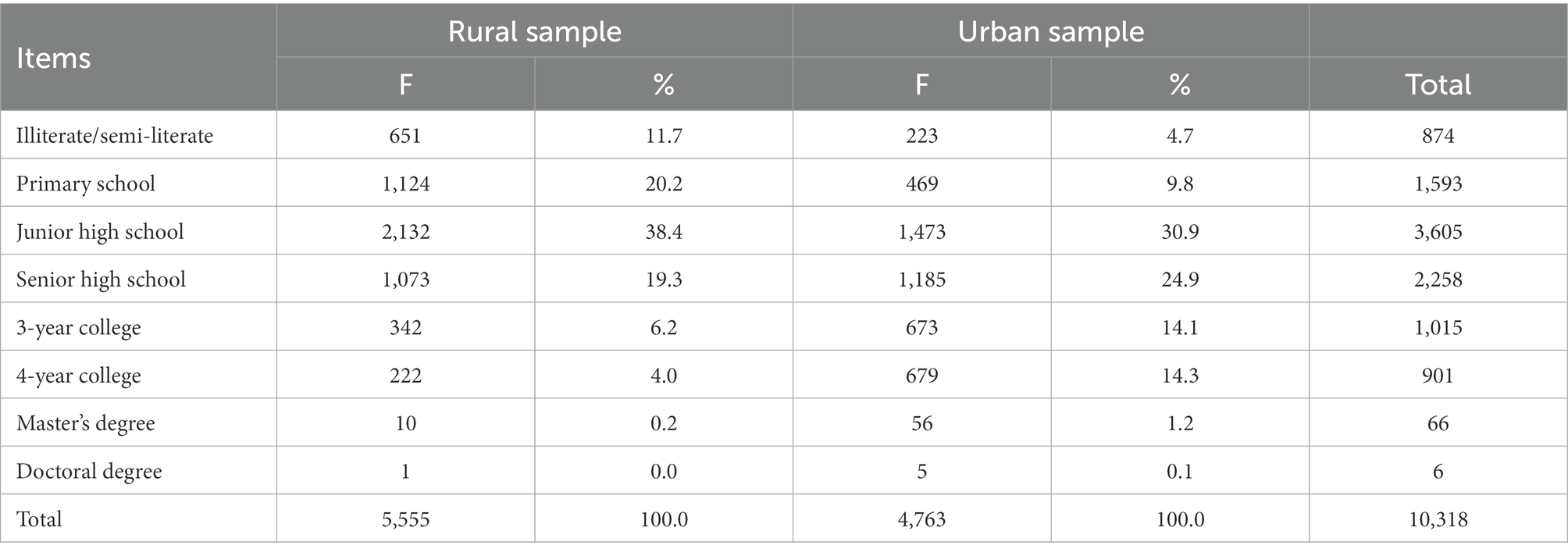
Table 1. Individual highest academic qualification and urban/rural classification variables based on data from the National Bureau of Statistics.
As shown in Table 2, among the selected female respondents, 79.0% have a senior high school education or below, with as many as 11.5% being illiterate/semi-illiterate. Meanwhile, 21.0% have college-level qualifications or above. In contrast, among the male respondents, 82.1% have a senior high school education or below, with only 6.2% being illiterate/semi-illiterate. This was 5.3% lower than the female respondents. Among the male respondents, 18.0% have 3-year college degree or above, which was 3.0% lower than the female respondents. As a whole, the female population shows a more obvious “bipolar” differentiation in terms of education level.
4.2. Evaluation of the structural model
According to the regression model, L = Ln(opportunity)[p/(1 – p)] = β0 + β1 father’s edu + β2 mother’s edu + β3 father’s occupation + β4 number of family members + β5 family’s annual income + μ. By regressing the data using the binary logistic command of the SPSS26.0 software, the sample processing results were obtained (see Table 3).
Table 4 presents the misjudgment matrix of the model. In this study, among the 8,330 people without access to higher education in the actual samples, 8,093 were correctly identified by the model and 237 were wrongly identified, for a correct rate of 97.2%. Among the 1988 people with access to higher education in the actual samples, 393 were correctly identified by the model and 1,595 were wrongly identified, for a correct rate of 19.8%. The field “the cut value is 0.500” in the footnote under the diagram indicates that if the prediction probability value was greater than the critical value of 0.5 (i.e., 50%), the correct prediction rate of variable classification was considered to be 100%. Otherwise, the correct prediction rate of variable classification was considered to be 0. Therefore, the correct prediction rate of the above model was 82.2%, and the result was within the acceptable scope (i.e., greater than 50%).
Table 5 presents the significance test results of the model. Step statistics refers to the likelihood ratio test results of each step compared with the previous step. Block refers to the likelihood ratio test results of Block n compared with Blockn – 1. Model refers to the likelihood ratio test results of the model after the variables in the previous model and the current model change. When Method = Forward: LR was selected, the three statistical results and the hypothesis test results were completely consistent. The above statistical results showed that the regression model passed the significance test.
When the significance value (Sig) is less than the cut value (i.e., 0.05), the null hypothesis is rejected. In this case, no significant difference was found between the observed value of the dependent variable and the predicted value of the model, so there was a significant difference between the predicted value and the observed value of the model. Otherwise, the null hypothesis could not be rejected, and the estimation of the model fit the data at an acceptable level. According to the goodness of fit test results in Table 6, in Step 5, the X2 value corresponding to the Hosmer–Lemeshow Test statistics of the model was 9.775, the degree of freedom was 8, and the Sig value was 0.281; that is, Sig > 0.05, and the difference was not significant. Therefore, the hypothesis that the predicted value would be consistent with the observed value could not be rejected. This indicated that the model had sound goodness of fit. Because of the difference between the predicted value of the model and the observed value, the hypothesis was accepted. There was a significant correlation between CAHE and family capital.
Table 7 presents the significance test results of the model parameters. The variables passing the Forward: LR test were father’s highest academic qualification, mother’s highest academic qualification, father’s occupation, number of family members, and family’s annual income. According to the Sig value of the significance of the regression coefficient, father’s highest academic qualification (Sig < 0.001), mother’s highest academic qualification (Sig < 0.001), father’s occupation (Sig < 0.001), number of family members (Sig < 0.001), and family’s annual income (Sig < 0.001) were all found to have a significant influence on CAHE.
Firstly, parents’ academic qualification has a significant positive influence on CAHE. The higher the parental academic qualification, the greater the probability of CAHE. Therefore, hypothesis H1 is accepted. As shown in Table 7, both parents’ highest academic qualification (illiterate/semi-illiterate, primary school, junior high school, and senior high school) significantly influenced the explained variables at a significance level of 1%. Notably, the mother’s academic qualification had a greater influence on CAHE than the father’s academic qualification, if viewed from the absolute value of regression coefficient B.
Secondly, when the father’s occupation was an official of a state organization, head of a mass organization or enterprise, professional or technical worker, production worker, or transport equipment operator, the regression coefficient B was positive. This is conducive to CAHE opportunities. In contrast, when the father’s occupation was office worker; commercial staff or service worker; agricultural, forestry, animal husbandry, or fishery and water conservancy worker; or soldier, the regression coefficient B was negative. This is not conducive to CAHE opportunities. Among these, father’s occupation (commercial staff and service worker) was significant at a significance level of 1%, father’s occupation (soldier) was significant at a significance level of 1%, and father’s occupation (office worker, agricultural, forestry, animal husbandry, or fishery and water conservancy worker) was significant at a significance level of 5%. Consequently, hypothesis H2 is accepted. Notably, as the father’s occupational status decreased, the probability of CAHE did not decrease accordingly. When the father’s occupation was production worker or transport equipment operator, the probability of CAHE rebounded significantly, which may be directly correlated to the Chinese population’s social and industrial structure.
Thirdly, number of family members had a significant influence on the explained variables at a significance level of 1%. At the same time, the number of family members was negatively correlated with CAHE. That is, as the number of family members increased, the probability of CAHE decreased accordingly.
Finally, annual family income had a significant positive influence on the explained variables at a significance level of 1%. Thus, hypothesis H3 has been accepted. This shows that when other conditions remain unchanged, the higher the annual family income, the greater the probability of CAHE.
5. Discussion
5.1. Influence of family cultural capital on children’s access to higher education
As a result of the empirical findings, it is confirmed that the possession of family cultural capital has a direct positive influence on CAHE, which supports the research hypothesis. Based on the empirical evidence, research hypothesis H1 has been accepted. This study shows that the possession of family cultural capital has a direct positive influence on CAHE. This may be directly related to intellectual factors, personal effort, supply of learning resources, or parental guidance, for example. Lissitsa and Chachashvili-Bolotin (2021) found that variations in individual effort, learning resources, and parental guidance stem largely from different levels of family cultural capital. Limited cultural capital negatively impacts children’s preparation and judgment when aiming toward higher education opportunities. These conclusions mirror the findings of another study that parents who are rich in cultural capital have a relatively positive attitude toward their children entering higher education. They consciously increase their educational investment, interact more with their children, and potentially encourage their children’s cultural literacy, interests, tastes, and ideas with a benign family cultural atmosphere (Cheng and Kaplowitz, 2016; Hu and Yin, 2021). Under such parental influence, these children often have a strong internal motivation to strive for higher education opportunities. They hope to develop their professional abilities through higher education and realize their own potential values. In contrast, families with weak cultural capital have comparatively ambivalent views on higher education. Most parents do not have a higher education background and are unlikely to recognize its value for their children’s future and personal growth. This parental ambivalence continues to restrict children’s understanding of higher education through inter-generation transmission (Hao and Pilz, 2021). Hu and Wu (2021) argued that families with more economic capital do not always have more cultural capital. They maintained that the key factor affecting family cultural capital is the parents’ academic qualifications. For example, the Chinese College Entrance Examination is designed to screen elite students. Parents with high academic qualifications have accumulated more cultural capital, so they can give their children an early competitive advantage. This inter-generation transmission is gradually converted into an exam score advantage.
Interestingly, this study finds that the influence of family capital on access to higher education is significantly greater for females than for males. Similarly, Si (2022) found that if a female comes from a family with better economic conditions, her family conditions have a greater positive influence on her access to education opportunities. In addition, compared to men, women’s access to higher education is more limited by family economic background (Guo et al., 2018).
The current study also found that mothers have a significantly greater influence than fathers on their CAHE, which may result from family tradition and the social division of labor. As Zhang et al. (2020) explained, mothers pay more attention than fathers to their children’s early social development and assume the most responsibility for their children’s education. In particular, the cultural capital investment of mothers from middle-stratum families is advantageous for their children’s educational achievements. This finding is similar to Hou et al.’s (2008) conclusion that mothers’ academic qualifications have significantly more influence on their CAHE than fathers’ academic qualifications.
5.2. Influence of family social capital on children’s access to higher education
A significant influence of family social capital on CAHE is confirmed by the empirical findings, thus supporting the research hypothesis. As previous studies have shown, parents with close social relations and shared values across a social network can rely on these relationships to receive support from others. Moreover, they can exploit the social capital in their relationship network to increase their children’s competitive advantage in education (Han, 2019). In modern eastern China, the elite screening system represented by the College Entrance Exam is the principal gateway to obtaining higher education opportunities. However, the competition for access to higher education opportunities begins long before the College Entrance Examination. This competition is often reflected in the family’s choice of educational resources for their children during the stages of preschool, primary school, junior high school, and senior high school. Currently, the distribution of educational resources in China indicates that eastern China is better resourced than central and western China, urban areas have more resources than rural areas, and key schools are better resourced than ordinary schools (Li and Qiu, 2018). In contrast, families with weak social capital usually have few powerful social relationships and a single source of information on higher education. This significantly limits parents’ expectations that their children will obtain higher education (Chen and Liu, 2021).
The regression analysis also found that children in larger families are less likely to access higher education. This may be directly related to parental values. Hoffmann et al. (2020) demonstrated that the number, gender, and especially the age of children in families with less social capital directly affect how much the parents invest in educational resources. However, another study (Zhu, 2019) suggested that the development of national modernization has weakened the influence of hereditary factors such as sex and race on children’s access to education. At the same time, the influence of individual effort has strengthened.
5.3. Influence of family economic capital on children’s access to higher education
According to the results, the level of family economic capital has a positive influence on CAHE, which confirms the research hypothesis. Since its reform and opening up, China’s market economy has developed vigorously. Under the production principle of giving priority to efficiency and consideration to fairness, the economic gaps between different strata and regions have expanded accordingly. The resulting differences in family economic capital have directly affected the continuity of children’s access to education. As another study found, the influence of family economic capital on CAHE is gradually increasing with the marketization of China’s higher education. Children from families with abundant economic capital can obtain more high-quality educational resources through after-school instruction and private tutors. If they fail their entrance examinations, they may still enroll in foreign universities. However, children from families with relatively weak family economic capital lack the means to access high-quality educational resources. Moreover, the expense of higher education potentially suppresses their academic expectations. Their material poverty and reduced expectations push them to consciously give up on opportunities for further study (Wu et al., 2020).
A previous study analyzed the average cost for undergraduate students attending certain colleges and universities in Beijing and found that students must bear a minimum personal cost of 11,596 RMB every year (Shen and Luo, 2021). The cost of higher education for economically disadvantaged families has decreased in recent years due to the improvement of the national scholarship and student loan system. However, living expenses—including clothing, food, housing, and transportation—that families must bear for their children during school remain higher than 10,000 RMB (Cai et al., 2019; Yang, 2022). Moreover, such an expenditure cannot be repaid in the short term. At the same time, since the expansion of college enrolment, the employment situation has become more competitive, while education costs have not decreased. Children from economically disadvantaged strata—especially those from rural families—often choose to terminate their studies at a particular educational transition stage, making the pragmatic judgment to enter employment as soon as possible for the economic benefit of their families (Mok and Marginson, 2021).
The results presented in this paper show that some children from the blue-collar stratum also have a comparative advantage in obtaining higher education opportunities. Mishra (2020) argued that individuals whose parents have weak social relationships may also be able to obtain higher educational returns. Due to the insecure environment of these disadvantaged strata, their members value educational opportunities and are eager to improve their social status through higher education. Furthermore, families with scarce social capital may concentrate on family capital to enhance their children’s educational competitiveness and help them pass the standardized entrance examination (Mishra, 2020). However, most families from disadvantaged strata are likely to consciously avoid or abandon this high-risk strategy.
5.4. Implications
This study concludes that family capital is an important factor affecting the stratification of CAHE. A family’s economic capital has a direct positive influence on CAHE. However, family cultural capital has a greater direct positive influence on CAHE. Families with low incomes are more likely to have parents with low education levels. This limits the educational resources they can offer their children. When parents in low-income families have greater cultural capital (e.g., a higher education), they can help their children be more competitive. Due to their weak risk tolerance, low-income families can benefit from government investment in economically disadvantageous regions. The government should improve its gradient compensation mechanism to reduce regional differences in the allocation of educational resources. In particular, the parents in low-income families tend to be less educated. These parents should cooperate with schools and communities to take professional courses in assisted learning, emotional counseling, decision-making, and voluntary service. Schools and parents can also learn from the Parent Teacher Association (PTA) model in the United States to increase parents’ involvement in their children’s education.
5.5. Limitations
This study did not include the entire sample from the CFPS (2010–2020) database, thus reducing the representativeness of the findings. Additionally, the authors lack a comprehensive understanding of alternative theories in demography, politics, and sociology, which would enable them to provide a more comprehensive assessment of equity in higher education. Future studies will build a stronger theoretical framework by using a broader sample. A more accurate mathematical model will also be developed. This will allow us to investigate how family capital influences children’s education acquisition at different levels and types of colleges and universities.
6. Conclusion
This study concludes that family capital is an important factor affecting the stratification of CAHE. Compared with family economic capital, family cultural capital has a more significant influence, benefiting children from elite strata. In addition, the influence of family capital on access to higher education is significantly greater for females than for males. The current study also found that mothers’ education has a significantly greater influence than fathers’ education on CAHE, which may result from family tradition and the social division of labor in China. Although family social capital influences access to higher education, no clear difference was found between strata. China’s political, economic, and social environment gives some children from the blue-collar stratum a comparative advantage. The regression analysis shows that children’s access to higher education does not decrease with the father’s lower occupational status. It also found that children from larger families are less likely to access higher education. Moreover, the children of production workers and transport equipment operators have a significantly higher probability of accessing higher education. These results demonstrate that not all forms of family capital create strata differences in terms of access to higher education. In poor families, family cultural capital has a greater influence on improving children’s competitive advantage in accessing higher education opportunities. When parents in low-income families have more cultural capital (e.g., higher education), they can help their children be more competitive.
Data availability statement
The original contributions presented in the study are included in the article/supplementary material, further inquiries can be directed to the corresponding author.
Ethics statement
Ethical review and approval was not required for the study on human participants in accordance with the local legislation and institutional requirements. Written informed consent for participation was not required for this study in accordance with the national legislation and the institutional requirements.
Author contributions
CL and QT presented the main idea and wrote the first draft of the manuscript. SA and CL interpreted the data and drafted the manuscript. PW reviewed the manuscript. SA and LT revised the manuscript based on the critical comments and finished the final submission. All authors contributed to the article and approved the submitted version.
Funding
The authors disclosed receipt of the following financial support for the research, authorship, and/or publication of this article: This work was partially supported by the Chinese Society for Technical and Vocational Education and the China Institute of Vocational and Technical Education for a New Era in 2022 (grant no. SZ22B34).
Acknowledgments
My sincere thanks go out to Dr. Muhammad Arif for his assistance in polishing this article and guidance throughout the submission process.
Conflict of interest
The authors declare that the research was conducted in the absence of any commercial or financial relationships that could be construed as a potential conflict of interest.
Publisher’s note
All claims expressed in this article are solely those of the authors and do not necessarily represent those of their affiliated organizations, or those of the publisher, the editors and the reviewers. Any product that may be evaluated in this article, or claim that may be made by its manufacturer, is not guaranteed or endorsed by the publisher.
References
Aitken, G., Jones, D., Fawns, T., Sutherland, D., and Henderson, S. (2019). Using Bourdieu to explore graduate attributes in two online Master’s programmes. Adv Health Sci. Theory Prac. 24, 559–576. doi: 10.1007/s10459-019-09885-6
Althusser, L. (2019). Philosophy and social science: introducing Bourdieu and Passeron. Theory Cult. Soc. 36, 5–21. doi: 10.1177/0263276419873373
Bauer, D., and Zanjani, G. (2021). Economic capital and RAROC in a dynamic model. J. Bank. Financ. 125:106071. doi: 10.1016/j.jbankfin.2021.106071
Bourdieu, P., and Passeron, J. C. (1990). Reproduction in education, society and culture, Vol. 4. Newbury Park, CA: Sage.
Breinholt, A., and Jæger, M. M. (2020). How does cultural capital affect educational performance: signals or skills? Br. J. Sociol. 71, 28–46. doi: 10.1111/1468-4446.12711
Cai, Y., Chapman, B., and Wang, Q. (2019). Repayment burdens of mortgage-style student loans in China and steps toward income-contingent loans. Econ. Educ. Rev. 71, 95–108. doi: 10.1016/j.econedurev.2018.10.006
CFPS. (2015). Data of CEPS 2013–2014. Available at: http://cnsda.ruc.edu.cn/index.php?r=projects/view&id=72810330
Chen, J.-J., and Liu, M. F. (2021). Does the internet expand the educational gap among different social classes? The protective role of future orientation. Front. Psychol. 12:647351. doi: 10.3389/fpsyg.2021.647351
Cheng, S.-T., and Kaplowitz, S. A. (2016). Family economic status, cultural capital, and academic achievement: the case of Taiwan. Int. J. Educ. Dev. 49, 271–278. doi: 10.1016/j.ijedudev.2016.04.002
Coleman, J. S. (1988). Social capital in the creation of human capital. Am. J. Sociol. 94, S95–S120. doi: 10.1086/228943
de Wit, H., and Altbach, P. G. (2021). Internationalization in higher education: global trends and recommendations for its future. Rev. High. Ed. 5, 28–46. doi: 10.1080/23322969.2020.1820898
Dimaggio, P. (1982). Cultural capital and school success: the impact of status culture participation on the grade of U.S High School Students. Am. Sociol. Rev. 47, 189–201. doi: 10.2307/2094962
Du, H. (2018). Rich dad, poor dad: the impact of family background on educated young people’s migration from peripheral China. J. Youth Stud. 21, 90–110. doi: 10.1080/13676261.2017.1343939
Duan, W., Guan, Y., and Bu, H. (2018). The effect of parental involvement and socioeconomic status on junior school students’ academic achievement and school behavior in China. Front. Psychol. 9:952. doi: 10.3389/fpsyg.2018.00952
Duerrenberger, N., and Warning, S. (2018). Corruption and education in developing countries: the role of public vs. private funding of higher education. Int. J. Educ. Dev. 62, 217–225. doi: 10.1016/j.ijedudev.2018.05.002
Ehsan, A., Klaas, H. S., Bastianen, A., and Spini, D. (2019). Social capital and health: a systematic review of systematic reviews. SSM-Popul. 8:100425. doi: 10.1016/j.ssmph.2019.100425
Gao, H., Ou, Y., Zhang, Z., Ni, M., Zhou, X., and Liao, L. (2021). The relationship between family support and e-learning engagement in college students: the mediating role of e-learning normative consciousness and behaviors and self-efficacy. Front. Psychol. 12:573779. doi: 10.3389/fpsyg.2021.573779
Gilleard, C. (2020). Bourdieu's forms of capital and the stratification of later life. J. Aging Stud. 53:100851. doi: 10.1016/j.jaging.2020.100851
Guo, X., Lv, B., Zhou, H., Liu, C., Liu, J., Jiang, K., et al. (2018). Gender differences in how family income and parental education relate to reading achievement in China: the mediating role of parental expectation and parental involvement. Front. Psychol. 9:783. doi: 10.3389/fpsyg.2018.00783
Guo, C., and Min, W. (2006). The effect of familial economical and cultural capital on educational attainment in China. J. High. Educ. 27, 24–31. doi: 10.1016/j.jaging.2020.100851
Han, Q. (2019). A literature review on the study of income distribution, education and education return rate-based on family background and gender differences. J. Bus. Fin. Account. 5, 43–50. doi: 10.20448/2002.52.43.50
Hao, T., and Pilz, M. (2021). Attractiveness of VET in China: a study on secondary vocational students and their parents. J. Educ. Work. 34, 472–487. doi: 10.1080/13639080.2021.1946492
Hoffmann, J. P., Thorpe, J. D., and Dufur, M. J. (2020). Family social capital and delinquent behavior in the United Kingdom. Soc. Sci. 9:178. doi: 10.3390/socsci9100178
Hou, L., Li, F., and Zheng, Q. (2008). The impact of family background on the access to quantity and quality of higher education: from social stratification perspective. J. High. Educ. 4, 272–281. doi: 10.4236/sm.2014.44028
Hu, A., and Wu, X. (2021). Cultural capital and elite university attendance in China. Br. J. Sociol. Educ. 42, 1265–1293. doi: 10.1080/01425692.2021.1993788
Hu, A., and Yin, C. (2021). The distinction between the absolute and relative advantages of cultural capital: different conceptualizations, different consequences. Sociology 55, 803–822. doi: 10.1177/003803852097358
Kaye, N. (2021). Evaluating the role of bursaries in widening participation in higher education: a review of the literature and evidence. Educ. Rev. 73, 775–797. doi: 10.1080/00131911.2020.1787954
Li, W., Gao, W., and Sha, J. (2020). Perceived teacher autonomy support and school engagement of tibetan students in elementary and middle schools: mediating effect of self-efficacy and academic emotions. Front. Psychol. 11:50. doi: 10.3389/fpsyg.2020.00050
Li, Z., and Qiu, Z. (2018). How does family background affect children’s educational achievement? Evidence from contemporary China. Chin. J. Sociol. 5, 1–21. doi: 10.1186/s40711-018-0083-8
Lissitsa, S., and Chachashvili-Bolotin, S. (2021). Occupational reproduction and mobility in STEM–parental narratives of their child’s occupational choice. Educ. Stud. 1-17, 1–17. doi: 10.1080/03055698.2021.1884047
Liu, D., and Morgan, W. J. (2020). Why do students enrol for postgraduate education in China? The influence of gender and of family habitus. Gend. Educ. 32, 177–193. doi: 10.1080/09540253.2018.1447092
Liu, L. M., Wagner, W., Sonnenberg, B., Wu, X. W., and Trautwein, U. (2014). Independent freshman admission and educational inequality in the access to elite higher education evidence from Peking university. Chin. Sociol. Rev. 46, 41–67. doi: 10.2753/csa2162-0555460403
Mishra, S. (2020). Social networks, social capital, social support and academic success in higher education: a systematic review with a special focus on ‘underrepresented’students. Rev. Educ. Res. 29:100307. doi: 10.1016/j.edurev.2019.100307
Mok, K. H., and Marginson, S. (2021). Massification, diversification and internationalisation of higher education in China: critical reflections of developments in the last two decades. Int. J. Educ. Dev. 84:102405. doi: 10.1016/j.ijedudev.2021.102405
Pokrovskaia, N. N., Ababkova, M. Y., and Fedorov, D. A. (2019). Educational services for intellectual capital growth or transmission of culture for transfer of knowledge—consumer satisfaction at St. Petersburg universities. Educ. Sci. 9:183. doi: 10.3390/educsci9030183
Roksa, J., and Kinsley, P. (2019). The role of family support in facilitating academic success of low-income students. Res. High. Educ. 60, 415–436. doi: 10.1007/s11162-018-9517-z
Romele, A. (2021). Technological capital: Bourdieu, post phenomenology, and the philosophy of technology beyond the empirical turn. Philos. Technol. 34, 483–505. doi: 10.1007/s13347-020-00398-4
Shen, H., and Luo, J. (2021). Higher Education and Investment in Knowledge: A Perspective from Talent Policies in Mainland China. in Universities in the Knowledge Society: The Nexus of National Systems of Innovation and Higher Education. eds. T. Aarrevaara, M. Finkelstein, G. A. Jones, and J. Jung (Cham, New York, USA: Springer), 83–102.
Shiell, A., Hawe, P., and Kavanagh, S. (2020). Evidence suggests a need to rethink social capital and social capital interventions. Soc. Sci. Med. 257:111930. doi: 10.1016/j.socscimed.2018.09.006
Si, W. (2022). Higher education expansion and gender norms: evidence from China. J. Popul. Econ. 35, 1821–1858. doi: 10.1007/s00148-022-00888-z
Van Bavel, J., Schwartz, C. R., and Esteve, A. (2018). The reversal of the gender gap in education and its consequences for family life. Annu. Rev. Sociol. 44, 341–360. doi: 10.1146/annurev-soc-073117-041215
Wu, L., Yan, K., and Zhang, Y. (2020). Higher education expansion and inequality in educational opportunities in China. High. Educ. 80, 549–570. doi: 10.1007/s10734-020-00498-2
Yang, P. (2022). China in the global field of international student mobility: an analysis of economic, human and symbolic capitals. Res. Comp. Int. Educ. 52, 308–326. doi: 10.1080/03057925.2020.1764334
Yao, G., Zhimin, L., and Peng, F. (2015). The effect of family capital on the academic performance of college students—a survey at 20 higher education institutions in Jiangsu Province. Chin. Educ. Soc. 48, 81–91. doi: 10.1080/10611932.2015.1014713
Zhang, F., Jiang, Y., Ming, H., Ren, Y., Wang, L., and Huang, S. (2020). Family socio-economic status and children’s academic achievement: the different roles of parental academic involvement and subjective social mobility. Br. J. Educ. Psychol. 90, 561–579. doi: 10.1111/bjep.12374
Zhao, J., and Qin, Y. (2021). Perceived teacher autonomy support and students' deep learning: the mediating role of self-efficacy and the moderating role of perceived peer support. Front. Psychol. 12:2177. doi: 10.3389/fpsyg.2021.652796
Zhimin, L., and Yao, G. (2015). Family capital social stratification, and higher education attainment—an empirical study based on Jiangsu Province. Chin. Educ. Soc. 48, 218–230. doi: 10.1080/10611932.2015.1085773
Keywords: Bourdieu’s capital theory, China family panel studies, blue-collar stratum, cultural capital, higher education, logistic regression model
Citation: Tan Q, Li C, Wu P, Abbas S and Teng L (2023) Family capital, social stratification, and access to higher education: An empirical study in mainland China. Front. Psychol. 13:1035715. doi: 10.3389/fpsyg.2022.1035715
Edited by:
María Luisa Zagalaz-Sánchez, University of Jaén, SpainReviewed by:
Songyu Jiang, Rajamangala University of Technology Rattanakosin, ThailandRubén Navarro-Patón, Universidade de Santiago de Compostela, Spain
Hanrriette Carrasco, University of Los Lagos, Chile
Deborah Sanabrias Moreno, University of Jaén, Spain
Copyright © 2023 Tan, Li, Wu, Abbas and Teng. This is an open-access article distributed under the terms of the Creative Commons Attribution License (CC BY). The use, distribution or reproduction in other forums is permitted, provided the original author(s) and the copyright owner(s) are credited and that the original publication in this journal is cited, in accordance with accepted academic practice. No use, distribution or reproduction is permitted which does not comply with these terms.
*Correspondence: Safdar Abbas,  c2FmZGFyYmxvY2gxOTg2QHlhaG9vLmNvbQ==
c2FmZGFyYmxvY2gxOTg2QHlhaG9vLmNvbQ==
†These authors have contributed equally to this work and share first authorship
 Qinyi Tan
Qinyi Tan Chencheng Li1†
Chencheng Li1† Safdar Abbas
Safdar Abbas Luyan Teng
Luyan Teng